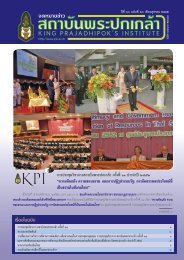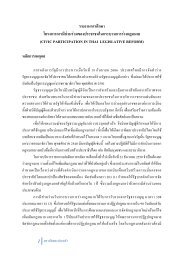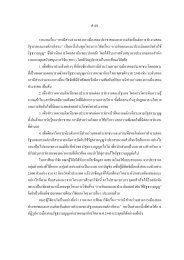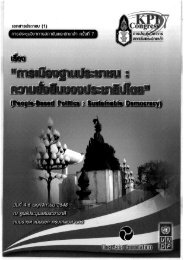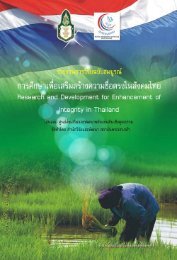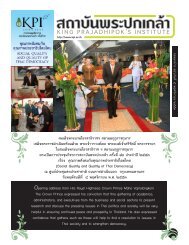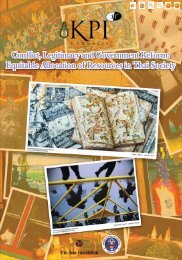SUFFiciENcy EcONOMy ANd GRASSROOtS DEvElOPMENt
SUFFiciENcy EcONOMy ANd GRASSROOtS DEvElOPMENt
SUFFiciENcy EcONOMy ANd GRASSROOtS DEvElOPMENt
Create successful ePaper yourself
Turn your PDF publications into a flip-book with our unique Google optimized e-Paper software.
184<br />
The Meaning of Sufficiency Economy <br />
International Conference<br />
Three Perspectives on Community Economies<br />
Since SE is fundamentally an alternative economic model, it seems more<br />
appropriate to glean ideas about community empowerment from literature on other<br />
alternative economies—in this case community economies—rather than from<br />
community development literature. This section considers three social science<br />
perspectives on community economies. The first and earliest is by Herman Daly and<br />
theologian John Cobb Jr., elaborated in their book For the Common Good:<br />
Redirecting the Economy toward Community, the Environment, and a Sustainable<br />
Future. Their approach reveals the fallacies in our current conception of economy,<br />
crafts an ethical alternative, and proposes policy applications for the United States.<br />
Next, economic anthropologist Stephen Gudeman looks at community economy<br />
from a different angle: his approach is to describe what he argues already exists,<br />
basing his theory on a rich ethnographic record. Finally, returning to ethics, feminist<br />
geographers JK Gibbson-Graham and their collective Community Economies<br />
Project aim to reimagine and recreate economies to value non-capitalocentric<br />
diversity and interdependence among other ethics. What is offered here are ideas for<br />
further consideration so as to strengthen SE as a community development approach.<br />
To establish conditions necessary for “economics for community”, Daly and<br />
Cobb call for a shift from individualism to “person-in-community” much like the<br />
idea of interdependence elaborated above. Regarding community, they state that the<br />
term “suggests people are bound up with one another, sharing, despite differences, a<br />
common identity” (1989:170). That is, community members self-identify as such<br />
based on their relationships with each other. Daly and Cobb specify three other<br />
requirements of community: 1) members must enjoy full participation in the<br />
community’s activities (especially decision making); 2) the community as a body<br />
must take responsibility for its membership as a whole; and 3) that responsibility<br />
includes respect for the diversity represented by individual members. They remark<br />
that community thus conceived is a matter of degree, but that economics for<br />
community favors development toward these ideals.<br />
In defining their economics for community model, Daly and Cobb take up<br />
Aristotle’s distinction between oikonomia and chrematistics. They understand<br />
chrematistics as “the branch of political economy relating to the manipulation of<br />
property and wealth so as to maximize short-term monetary exchange value to the<br />
owner” (138). They explain that the GDP is essentially a chrematistic model with the<br />
additional (erroneous) assumption that individual economic welfare is correlative<br />
with overall market growth. Oikonomia, by contrast, “is the management of the<br />
household so as to increase its use value to all members of the household over the<br />
long run.” Daly and Cobb continue, “If we expand the scope of the household to<br />
include the larger community of the land, of shared values, resources, biomes,<br />
institutions, language, and history, then we have a good definition of economics for<br />
community” (138). They state that oikonomia differs from chrematistics in three<br />
ways: 1) it takes the long-run rather than the short-run view; 2) it considers costs and



